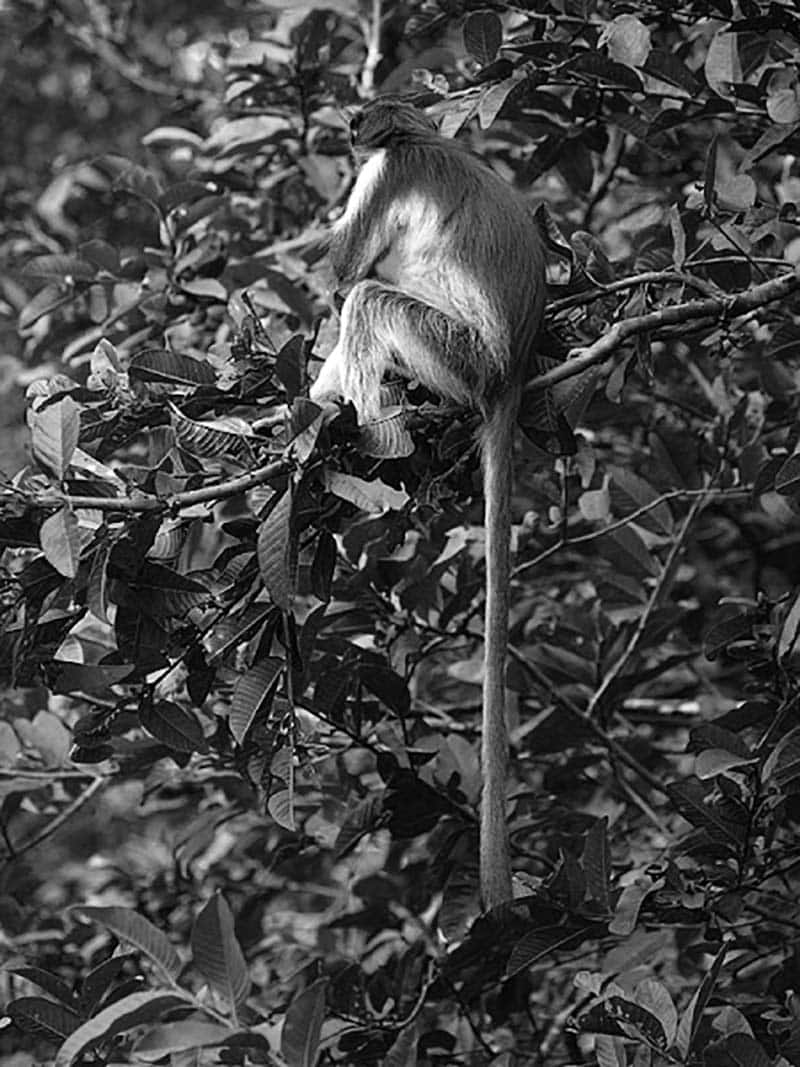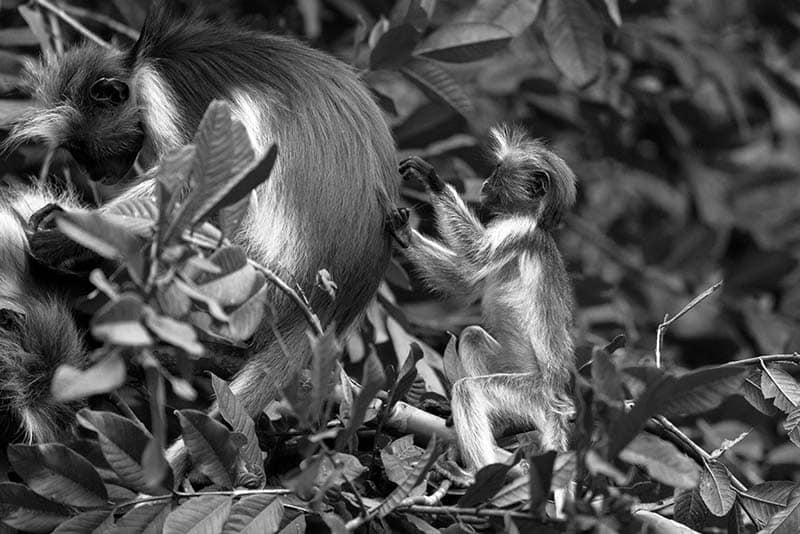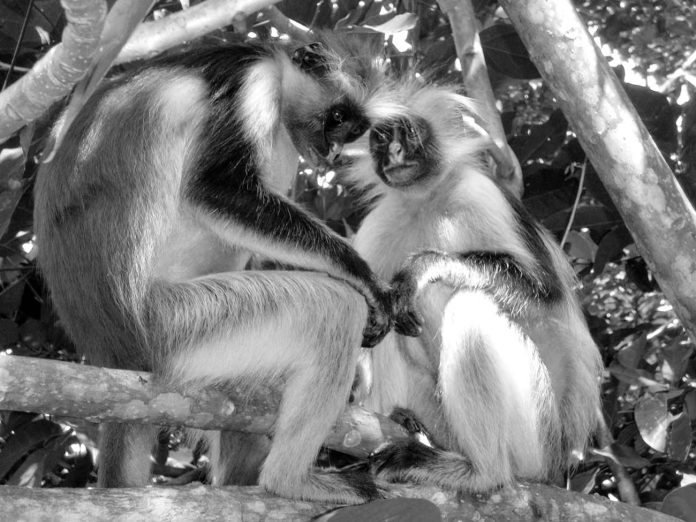Zanzibar Red Colobus Monkey Facts – Evolution, Habitat, Behavior and More
The Zanzibar Red Colobus (Piliocolobus kirkii) is a red colobus monkey species that is only found on Unguja, the principal island of the Zanzibar Archipelago off Tanzania’s coast. Kirk’s red colobus is named after Sir John Kirk, the British Resident of Zanzibar, who was the first to bring it to the notice of zoologists. It is presently listed as an endangered species and was designated as Zanzibar’s flagship species for conservation in the mid-1990s. Conservationists are striving to engage with the local authorities to develop a suitable, effective plan to safeguard the population and environment. The species’ habitat is confined to the archipelago, which poses a challenge. The species has been classed three times, first in the Colobus genus, then in the Procolobus genus, and finally in the Piliocolobus genus.
Red Colobus Zanzibar History and Taxonomy
The Zanzibar red colobus population, Piliocolobus kirkii, is thought to represent a population of red colobus that became isolated on the island as sea levels rose at the end of the Pleistocene era. Furthermore, mitochondrial data suggests that red colobus phylogenetic groups have been genetically separated from one another since the Pliocene.
The skull anatomy of P. kirkii has shown that it is a separate species from mainland Piliocolobus. Its morphological development of size has accelerated, which is thought to be the consequence of the island’s isolation and environmental factors such as competition, habitat, predation, and/or resource availability. No indication of population bottlenecks has been found in the species.
In contrast to mainland colobus monkeys, P. kirkii has a smaller skull, which is consistent with Foster’s rule (also known as the island rule), which states that when resources are few, the original (bigger) species shrinks with time.
Male Zanzibar Red Colobus Monkeys exhibit pedomorphic features such as a shorter face, bigger orbits, and a larger neurocranium than females. It’s unclear when and where this evolutionary transition took place.
- kirkii is more closely linked to P. gordonorum (Udzungwa red colobus) than other red colobus species, according to molecular analysis.
This study also determined that P. kirkii split from its sister species P. gordonorum roughly 600,000 years ago, indicating an earlier evolutionary age than the prior notion that it split from P. gordonorum during the last glacial era. The species has been classed twice, first in the Colobus genus, then in the Procolobus genus, and finally in the Piliocolobus genus.
Kirk’s red colobus is another frequent name for it, named for Sir John Kirk (1832–1922), who is British but was residing in Zanzibar. He was 1st brought to the notice of zoologists.
Zanzibar Red Colobus Physical Description
The coat of this Old World monkey varies in color from dark red to black, with a black stripe running down the shoulders and arms and a light underbelly. It has a distinctive pink mark on its nose and lips, and its black face is capped with long, white hair. The Zanzibar red colobus also has a long tail that is primarily utilized for balance and is not prehensile. The species’ sexual dimorphism is typically low, meaning females have minimal change in body size and color from their male counterparts. In most communities, the females outweigh the men. The species has a tiny skull and a rotund body form, with males weighing up to 12 kg and females weighing up to 10 kg. Adults with substantially distinct facial characteristics can tell each other apart in a crowd.

The term “colobus” derives from the Greek ekolobóse, which means “he cut short,” and refers to the primate’s much smaller stature, or total absence of an opposable thumb, as compared to other primates.
To compensate, they have four long fingers that create a powerful hook, enabling them to grab branches and climb with ease.
Because of its pungent odor, the island locals have nicknamed the Zanzibar red colobus poison monkey (kima punju in Swahili). This has led to unfavorable perceptions of the monkey, with some even claiming that it has a harmful impact on the trees on which it feeds, eventually destroying the trees.
The Red Colobus Monkey Zanzibar Tanzania Habitat
The Zanzibar red colobus may be found in three kinds of wood in the archipelago of Zanzibar.
It has a broad range of habit tolerance, although it is mostly an arboreal species that favors drier environments over wetter ones. Coastal rag scrub and coastal thickets are among its preferred habitats, although they may also be found in agricultural regions and mangrove swamps, the latter of which supplies food all year. When located in agricultural regions, the monkey becomes more used to people and approaches them more closely.
Only between 1,600 to 3,000 monkeys remain, and half of the monkeys found on the islands now reside outside of protected areas.
Jozani National Park, with its 25 km2 (9.7 sq mi) of the land reserve, is the monkey’s biggest and most important area of protection and habitat.
It’s on the main island, and the local populations have been extensively researched in terms of ecology and behavior. Despite this, several groups of the Zanzibar Red Colobus have been discovered in shambas (Swahili meaning “farmland”) around the park. When compared to the park reserve, larger densities of red colobus have been found residing in more coherent groups in these shambas close to the park. The occurrence of some of these monkeys residing continuously beyond the designated park reserve zone might put the groups in jeopardy.
Zanzibar Red Colobus Behavior
The groups normally comprise up to four adult males and a large number of adult females, with a male-to-female ratio of 1:2.
The gathering also includes young individuals of diverse ages. A troop of monkeys may include anything from 30 to 50 members. The species is a highly gregarious animal, and during the time between meals, it may be seen playing and grooming. Males, unlike females, have deep relationships in groups, working together to preserve their group and even grooming one another.

Zanzibar Red Colobus Feeding
Feeding is a communal activity as well. It starts feeding in the morning and becomes more active as the day progresses. Males’ loud cries signal that the group is ready to travel to a different tree to eat. This monkey is mostly a foliovore, with young leaves accounting for half of the leaves eaten on average. Unripe fruit, seeds, flowers, and leaf shoots are also eaten by them. It also eats bark, rotting wood, and dirt, according to reports. It is one of the only species that does not consume ripe fruits; it has a sacculated stomach with 4 compartments dedicated to the breakdown of plant materials, but it is unable to digest the sugars found in mature fruits. Because the monkey eats young leaves (though not exclusively), it sometimes consumes charcoal, which is thought to help them digest the toxins (perhaps phenolic compounds) contained in the young leaves of the Indian almond and mango trees. The practice of eating charcoal is assumed to be a learned behavior that is handed down from mother to child. It was discovered that the presence of charcoal deposits made these monkeys more inclined to live in locations with phenolic-rich trees as a food source. However, it has been discovered that the activity is not carried out by all inhabitants on the islands, but rather by those that eat more perennial and exotic vegetation.
Because certain populations of the Zanzibar Red Colobus feed on mangroves, it’s only natural for the monkey to ingest more sodium chloride (NaCl). As a result, these monkeys have been spotted drinking water straight from tree holes or licking water off of leaves. This creative action demonstrates the monkey’s ability to adapt to new ecological and environmental conditions.
During the dry season, one of the monkey’s major foods, the Indian almond tree, sheds its leaves, causing the monkey to go outside park limits in order to increase its eating area. This puts the colobine, which is already vulnerable, in jeopardy.
Zanzibar Red Colobus Reproduction
Males acquire sexual maturity around the age of 3–3.5 years, whereas females reach it around the age of two years.
The enlargement and vivid red coloring of the genital region may clearly identify females nearing estrous. This informs men that the female in question is ready to mate. Males will also use their fingers to test the female’s birth canal before mating. This is quickly followed by a sniffing of the region to detect estrogen and progesterone, which aids the male in determining whether or not the female is ready to procreate.
Colobus monkeys have a 6-month gestation period and have 1–2 offspring every two years. Parental care is demanding, and it is often shared by many females in the group. Between September and December, around 76 percent of offspring are born. When a new male monkey joins a group with babies, infanticide has been reported on occasion.
According to research, the opportunity to expand their diet, which charcoal use allows for in part, explains the increased birth rates and densities that result from resource scarcity.
Zanzibar Red Colobus monkeys living in coral rag forests have a greater birth rate than those living in mangroves.
Colobines on Uzi Island had higher birthing rates in October–December, followed by those on Kiwengwa, on the main island’s eastern side, in January–February.
Infant mortality may be quite high, with half of all newborns dying before reaching the age of six months. However, compared to mainland colobus monkeys, birth rates are lower, and interbirth intervals are longer. According to research, this is a result of altered ecosystems, but mainland colobi remain unaffected.
Zanzibar Red Colobus Communication
In comparison to other members of the Colobinae subfamily, red colobus species have a small larynx. In contrast to the deep bass of males in black-and-white colobus species, the male’s cry is more of an alto or soprano. Because the red colobus from Zanzibar is non-territorial in nature, it seldom makes territorial threat cries. The “bark”, “chist”, or “wheet” are Zanzibar red colobus distress and warning noises. When the monkey displays his control over the group and checks the sexual state of his females, he makes one of the loudest sounds.
The ‘alerting signal’ is the most common call heard in or around Jozani Forest. This is a call that draws attention and is developed from the progression call. When there are alterations in the surrounding environment, like as changes in the weather or animal activity in close proximity to the group, chirps and grunts are produced. Most arboreal animals have two distinct alerting cries, one for when a predator is on land and another for when a predator is flying. However, due to a scarcity of bigger birds of prey in Zanzibar, such cries are seldom heard. Young animals, on the other hand, make such cries when they encounter shadows because of their smaller size and susceptibility.
Because the Zanzibar red colobus is such a sociable creature, it has a distinct cry for when it is alone for a period of time and feels insecure or endangered. The young are more likely to produce such a call that sounds like a loud scream, although adults are also likely to make some form of the cry (when considered essential).
Zanzibar Red Colobus Conservation
The monkey’s endangered status is due to a variety of circumstances. First, increased deforestation has reduced resources and habitat; second, it is killed for meat and pet markets. Various initiatives have been undertaken to safeguard the species in order to combat population reduction. To attempt to re-establish the monkey’s population, specimens were relocated to Ngezi Forest on Pemba Island in 1974. However, 20 years after the transfer to the island, only one group of red colobus from Zanzibar was discovered, and the number was approximated to be between 15 and 30 individuals based on limited encounters and conversations with residents. Researchers determined that the group had most likely survived, but that it had not grown in numbers, probably owing to negative interactions with people. Some people in Pemba have superstitions about monkeys, believing that they bring ill luck to farmers. This might explain why they haven’t seen a large increase in population.
The Zanzibar red colobus is threatened by habitat degradation on the Uzi and Vundwe Islands, especially coral rag woods. Poisoning, netting, and the disappearance of monkeys and other animals have also been documented.
Attempts to save the Zanzibar Red Colobus species have been attempted in a variety of ways. One initiative was working with the World Wildlife Fund in Menai Bay, which is directly west of Uzi Island. The Zanzibar red colobus was named the flagship species in a long-term research on population, human effect, and behavior supported by the Wildlife Conservation Society.
The African Convention, by classifying the species as ‘Class A,’ has aided in its protection.
‘Class A’ is defined as follows in the African Convention on the Conservation of Nature and Natural Resources document:
Class A species are completely protected across the entire territory of the Contracting States; hunting, killing, capturing, or collecting specimens is permitted only with the approval of the highest competent authority in each case, and only if necessary in the national interest or for scientific purposes.
It has been proposed that one of the most effective ways to support monkey conservation is to simply raise knowledge about it – that it is not a dangerous animal and that it may potentially benefit the region’s economy by attracting tourists. On the island of Unguja, this has been the case (Zanzibar). It would also be required to create and define protected zones.
For more articles related to Wildlife in Tanzania (Animals), click here!


































